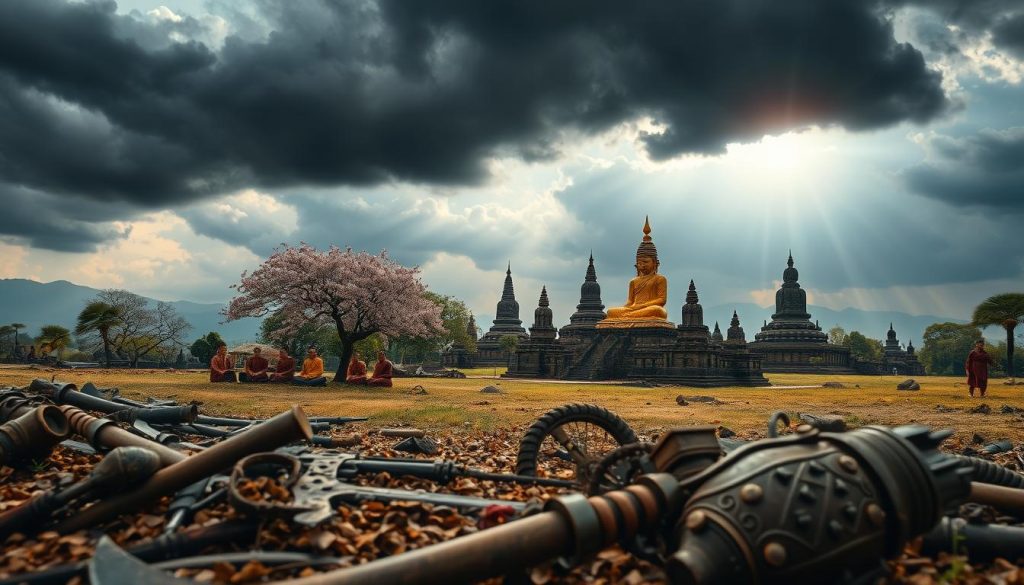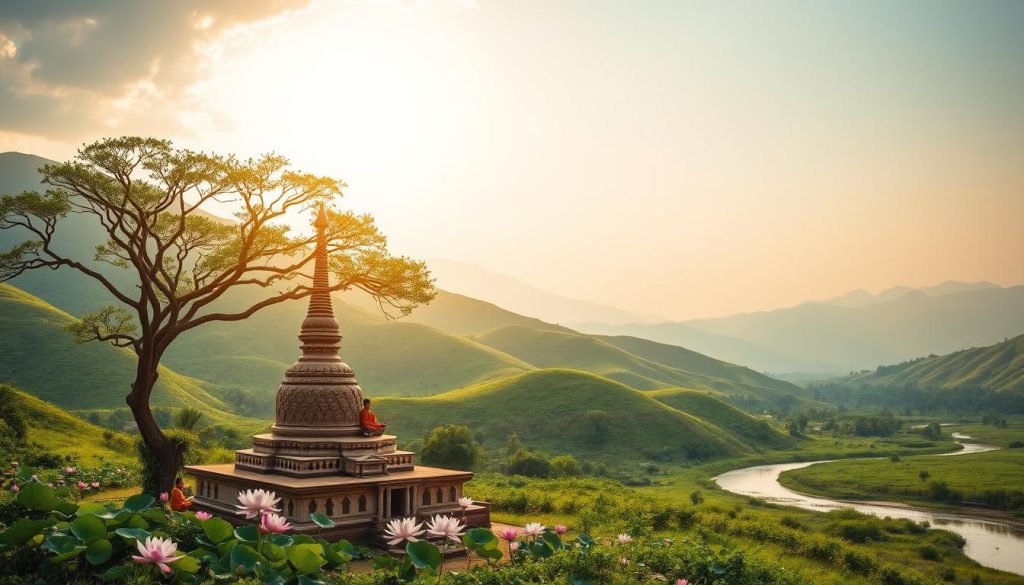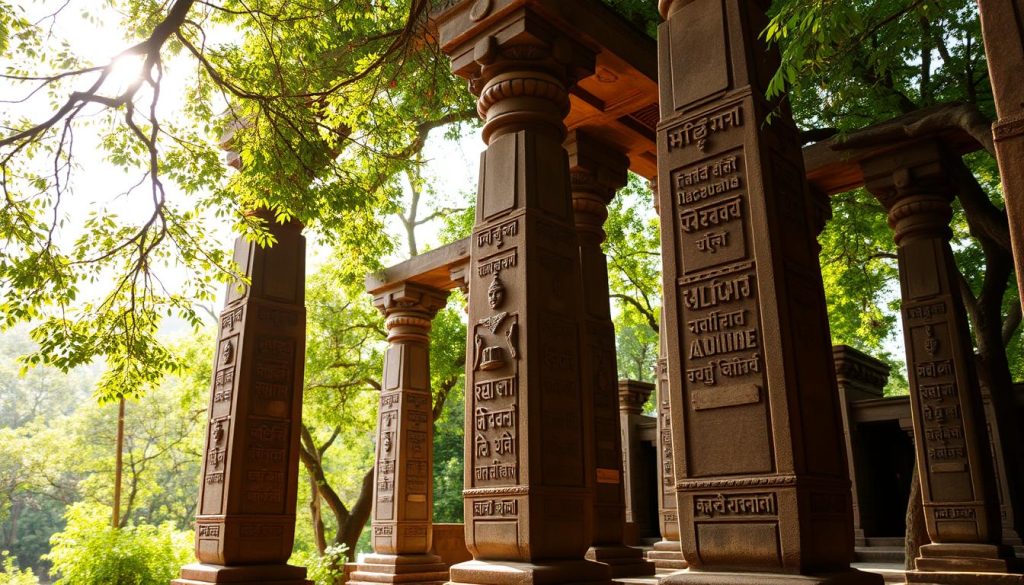How Kalinga War Impact the Spread of Buddhism
Imagine seeing an empire change, where war’s horrors turned to compassion and peace. This is the story of the Kalinga War and its big impact on Buddhism in ancient India. The Mauryan Emperor Ashoka’s victory in Kalinga led to over 100,000 deaths, a tragedy that changed history.

But this event also made Ashoka turn to Buddhism. He then spent his life spreading the Buddha’s teachings. The Kalinga War, once known for military power, sparked a deep spiritual change. This change shaped ancient Indian history.
Key Takeaways
- The Kalinga War was a key event in ancient Indian history that deeply affected Buddhism’s spread.
- The war’s huge loss of life, over 100,000, led to Emperor Ashoka’s conversion to Buddhism.
- Ashoka’s embrace of Buddhism and his Dhamma policy helped spread the religion across South Asia.
- The Kalinga War was a turning point in the Mauryan Empire’s growth and the region’s transformation.
- Archaeological finds and Buddhist centers show the Kalinga War’s lasting effect on Buddhism’s growth.
The Brutal Reality of Kalinga War and Its Immediate Aftermath
The Kalinga War happened in the 3rd century BCE. It left a deep mark on the Indian subcontinent. Over 100,000 people died, and many more were hurt or taken prisoner.
This war’s effects were huge. It changed how Buddhism spread in the region.
The Scale of Destruction and Human Cost
The Kalinga War was very destructive. The battlefield was filled with dead soldiers. Nearby towns and villages were destroyed.
Many families were broken, and communities were left in ruins.
Ashoka’s Initial Response to the Carnage
Emperor Ashoka was shocked by the war’s bloodshed. Ashoka’s conversion to Buddhism likely happened right after the war. He was deeply moved by the suffering he saw.
Psychological Impact on Emperor Ashoka
The Kalinga War deeply affected Ashoka. He was deeply shaken by the destruction. This led him to give up violence and follow Dhamma.
His new path would greatly influence Buddhism’s growth in the area.
“The Kalinga War was a pivotal moment in Ashoka’s life, transforming him from a ruthless conqueror to a compassionate ruler committed to the teachings of Buddhism.”

Kalinga War Impact the Spread of Buddhism in the Region
The Kalinga War was a key event in ancient Indian history. It deeply affected the spread of Buddhism in the area. Emperor Ashoka, moved by the war’s devastating loss, changed his ways. This change would greatly influence Buddhism in South Asia.
Ashoka’s guilt over the Kalinga War led him to follow Buddhism. This religion teaches non-violence and kindness. His new beliefs helped Buddhism grow fast across the Mauryan Empire. This empire once stretched from Afghanistan to Bangladesh.
| Region | Buddhist Expansion | Significance |
|---|---|---|
| Central Asia | Ashoka’s missionaries traveled to the Kushan Empire, introducing Buddhism to the region. | This laid the foundation for the eventual spread of Buddhism along the Silk Road trade routes. |
| Southeast Asia | Buddhist missionaries were sent to the Malay Peninsula, Burma, and Thailand, establishing monasteries and converting local populations. | The Mauryan influence played a crucial role in the early spread of Buddhism in Southeast Asia. |
| South India | Ashoka’s edicts and rock inscriptions were found throughout the Deccan region, indicating the strong presence of Buddhist teachings. | The Mauryan expansion facilitated the integration of South India into the broader cultural and religious landscape of ancient India. |
The Kalinga War, though tragic, opened the door for Buddhism’s growth in South Asia. Ashoka’s change and his Dhamma policies were key. They show the lasting effect of this important time in ancient Indian history.

Ashoka’s Transformation and Implementation of Dhamma
The Kalinga War was a turning point for Emperor Ashoka. The destruction and loss of life deeply affected him. This led to a major change in his life.
Ashoka turned to Buddhism and started the Dhamma policy. This had a big impact on Buddhism’s spread in the area.
The Principles of Dhamma Policy
Ashoka’s Dhamma policy was based on non-violence, compassion, and fair governance. He believed in religious tolerance and the value of life. He also thought rulers should help their people.
These ideas were written in his edicts. They were carved on stone pillars and rocks across his empire.
Buddhist Missionaries and Their Routes
Ashoka was deeply devoted to Buddhism. He sent Buddhist missionaries to places like Sri Lanka, Afghanistan, and Central Asia. They used trade routes to spread the dhamma policy and influence of Ashoka on buddhism.
Establishment of Buddhist Centers
Ashoka supported the building of many buddhist monuments and centers. These included monasteries, stupas, and sacred sites. They were places for learning, worship, and community.
These centers were built along important trade routes. This helped spread Buddhist teachings and influence of Ashoka on buddhism.
Ashoka’s change and Dhamma policy were key to Buddhism’s growth. He promoted Buddhism’s core values, sent missionaries, and built a network of centers. His impact on Buddhism’s spread is huge.
Archaeological Evidence and Buddhist Monuments
The Kalinga War changed Emperor Ashoka’s life and the region’s culture. Many archaeological sites and Buddhist monuments in Bhubaneswar and India show Ashoka’s efforts to spread Buddha’s teachings.
The area has many rock edicts that tell Ashoka’s story. These inscriptions on rocks show how he changed from a fierce warrior to a kind Buddhist leader. They prove his dedication to Buddhism.
In Bhubaneswar, places like Dhauli and Ashokan Rock Edicts are famous. The Dhauli Hills are known for Ashoka’s Rock Edicts. They tell of his regret over the Kalinga War and his turn to Buddhism.
Bhubaneswar also has many Buddhist monuments like stupas, monasteries, and temples. These structures, from the Mauryan era, show Buddhism’s lasting impact. They draw visitors, highlighting the Kalinga War’s role in spreading Buddhism in ancient India.
The sites in Bhubaneswar and nearby areas connect us to the Kalinga War’s aftermath. They remind us of Ashoka’s change and its effect on the region. This change helped Buddhism spread widely, leaving a lasting mark.
Long-Term Effects of the Kalinga War on Buddhism’s Expansion
The Kalinga War between Emperor Ashoka and Kalinga had a big impact on Buddhism in South Asia. At first, the war caused a lot of damage and loss. But Ashoka’s change later would greatly affect Buddhism’s future.
After the Kalinga War, Ashoka changed a lot. He was deeply moved by the suffering he caused. He then gave up violence and followed the Buddha’s teachings. This change greatly influenced Buddhism’s growth in the area.
Ashoka became very dedicated to Buddhism. He sent Buddhist teachers to places like Sri Lanka, Myanmar, and Afghanistan. They shared the Buddha’s teachings with many people.
- Ashoka’s support helped build many Buddhist monasteries and schools. This made Buddhism stronger in the region.
- His own conversion to Buddhism and his efforts to apply its teachings in his rule inspired others. Many followed the Buddha’s path.
The Kalinga War’s effects on Buddhism are still seen today. Many Buddhist sites and inscriptions across South Asia show Ashoka’s lasting influence. This shows how important this event was in ancient Indian history.
“The Kalinga War, though initially a horrific episode, ultimately paved the way for the unparalleled growth and dissemination of Buddhist thought and practice throughout the subcontinent and beyond.”
Ashoka’s change from a fierce warrior to a Buddhist supporter was a key moment. The Kalinga War, though terrible at first, helped Buddhism spread widely. It changed the subcontinent and beyond.
Conclusion
The Kalinga War had a big impact on Buddhism’s spread in the area. Emperor Ashoka changed from a fierce warrior to a kind leader who followed the Buddha’s teachings. This change was a key moment in South Asia’s history.
Ashoka’s choice to follow Buddhism and his Dhamma policy helped spread the religion far and wide. This was across his huge empire.
Archaeological finds and Buddhist monuments across the subcontinent show Ashoka’s lasting effect on Buddhism. The Kalinga War was initially very bad. But it led to Buddhism spreading more peacefully, thanks to Ashoka’s nonviolence and Dhamma principles.
Today, the Kalinga War and Ashoka’s influence on Buddhism are still seen. The religion continues to shape South Asia’s culture and spirit. This moment in history reminds us of compassion’s power and how one person can change things.
FAQ
What was the impact of the Kalinga War on the spread of Buddhism in the region?
The Kalinga War was a turning point for Buddhism in South Asia. Emperor Ashoka’s Mauryan Empire fought this war. The war’s destruction and loss of life deeply affected Ashoka.
He then turned to Buddhism. Ashoka’s new beliefs led to his Dhamma policy. This policy helped spread Buddhist teachings across South Asia.
How did Ashoka’s personal transformation after the Kalinga War influence the spread of Buddhism?
The Kalinga War changed Ashoka deeply. He saw the war’s horrors and chose to reject violence. He then followed Buddhism’s teachings.
Ashoka’s Dhamma policy supported Buddhism’s growth. He built Buddhist centers and sent missionaries. This helped Buddhism spread widely in his empire.
What archaeological evidence supports the impact of the Kalinga War on the spread of Buddhism?
Archaeology shows Buddhism’s growth after the Kalinga War. Rock edicts and inscriptions tell of Ashoka’s efforts. They show his support for Buddhism in Bhubaneswar and other places.
How did the Mauryan Empire’s expansion contribute to the spread of Buddhism?
Ashoka’s Mauryan Empire was key to Buddhism’s spread. His Dhamma policy and support for Buddhism helped it grow. This allowed Buddhism to spread in the empire and beyond.
What were the long-term effects of the Kalinga War on the expansion of Buddhism?
The Kalinga War and Ashoka’s conversion to Buddhism had lasting effects. Ashoka’s actions helped Buddhism spread. He built centers and sent missionaries, spreading Buddhist teachings far and wide.
The war’s impact was felt for a long time. It changed the religious and cultural scene in South Asia.







